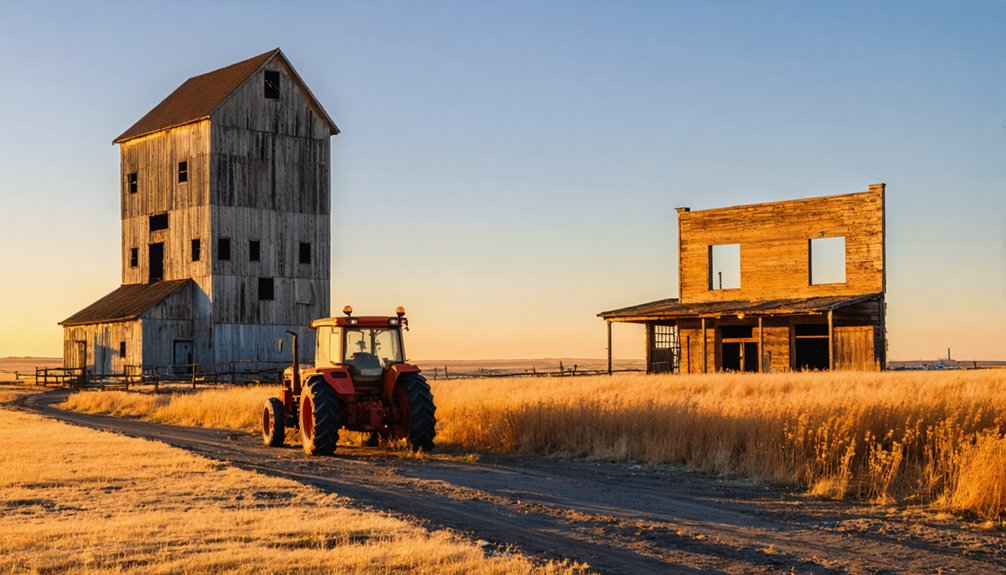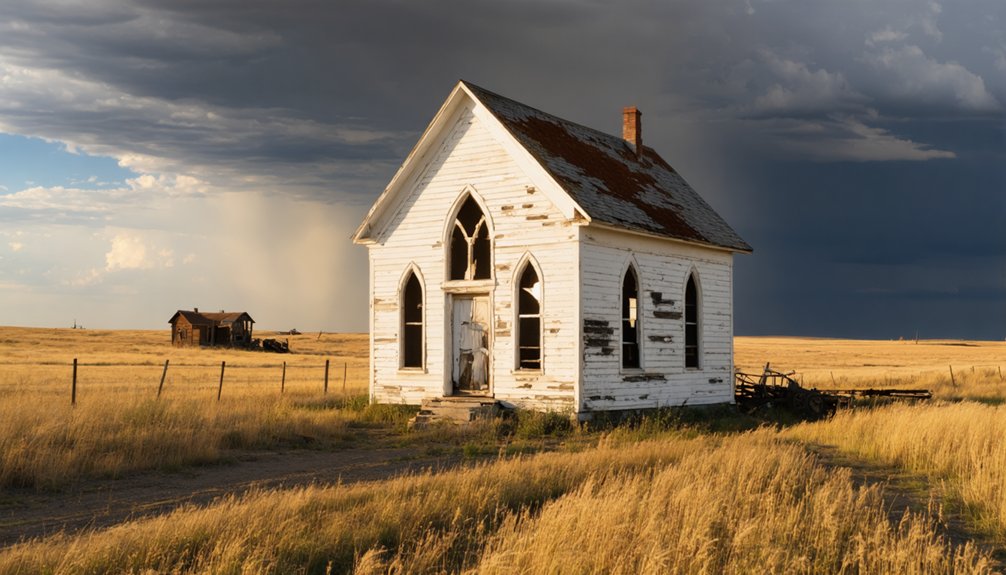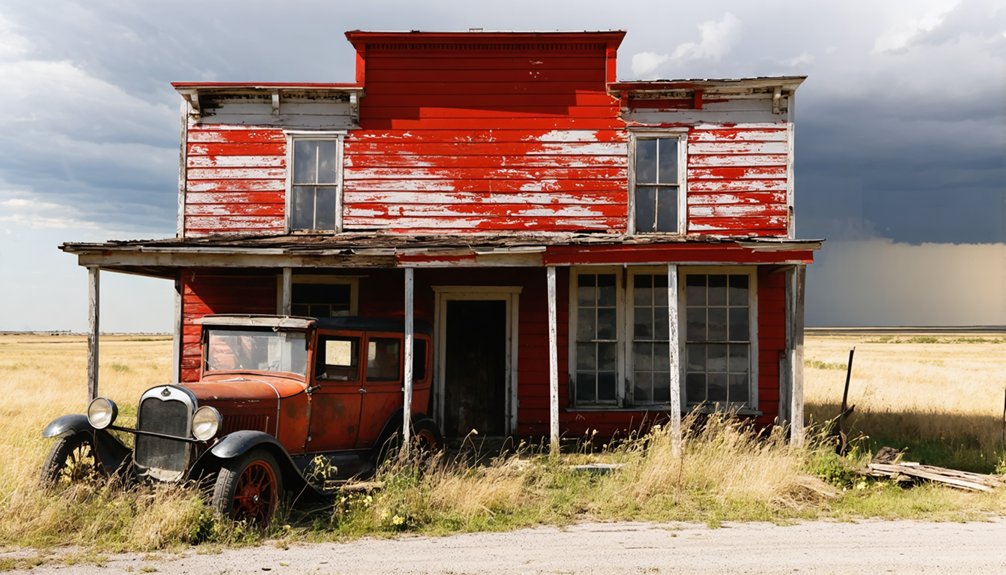You’ll find Nasby’s story in South Dakota’s pioneer past, where Czech immigrants and hopeful settlers built a vibrant railroad community in the late 1800s. The town thrived with general stores, the Calloway Hotel, and the Odd Fellows Lodge hosting gatherings and celebrations. While nature has now reclaimed the area where buildings once stood, descendants keep the town’s memory alive through family heirlooms and stories that reveal the heart of this prairie settlement.
Key Takeaways
- Nasby was a South Dakota settlement established during the Homestead Act era, featuring a railroad station, general stores, and vibrant community spaces.
- Czech immigrants significantly influenced the community in the 1880s, contributing to farming practices and cultural traditions.
- The Calloway Hotel, Odd Fellows Lodge, and local schoolhouse served as primary gathering places for community events and celebrations.
- Population decline led to closures of essential services, including the post office, school, and church, transforming Nasby into a ghost town.
- Today, natural reclamation has replaced all physical structures, with open fields and pastures dominating the former townsite.
The Birth of a Prairie Settlement
While many settlers streamed westward to California’s goldfields in the mid-1800s, the Dakota Territory’s vast prairie lands beckoned a different kind of pioneer. You’d find these determined souls claiming 160-acre plots under the Homestead Act of 1863, facing homesteading challenges that tested their resilience daily.
With timber scarce, they carved out lives using innovative prairie adaptations, building sod houses from thick prairie turf cut into substantial blocks. Railroad company promotions helped attract waves of new settlers to the region. Sioux tribes had long inhabited these lands before the settlers arrived.
Resourceful pioneers turned the very earth into shelter, stacking dense prairie sod into sturdy homes on the untamed plains.
The Dakota Boom of the 1880s brought waves of newcomers to places like Nasby, transforming raw grassland into farmable plots. You can imagine their determination as they battled isolation, harsh weather, and limited resources.
Yet they persisted, driven by the promise of land ownership and the freedom to build their own future on the fertile prairie soil.
Life in Early Nasby
You’d have found early Nasby bustling with the daily activities of pioneers tending to their farms, managing local businesses, and gathering supplies at the general store.
The railroad station served as the community’s lifeline, where you could watch freight cars bringing essential goods and materials while passenger trains carried visitors and new settlers to the growing town. Like many communities of the era, the rural general stores were vital hubs for local farmers and residents.
As station workers managed the loading and unloading of cargo, farmers would bring their grain and livestock to be shipped to distant markets, creating a constant flow of commerce and activity around the tracks. Many of these early settlers were Czech immigrants who arrived in the 1880s, bringing their cultural traditions and farming expertise to the area.
Daily Pioneer Activities
As the early settlers of Nasby established their roots in South Dakota, their daily lives revolved around essential activities that sustained both individual families and the broader community.
You’d find pioneer survival centered on working the land with basic tools, raising livestock, and cultivating crops. When winter’s harsh grip took hold, you’d rely on hunting and gathering to supplement your food stores. The Homestead Act of 1862 brought many eastern settlers to claim land and establish farms in the area.
Community resilience showed in the way you’d help build your neighbor’s barn, share resources, and gather for harvest festivals. You’d trade with nearby settlements, bartering goods you couldn’t produce yourself.
In your spare moments, you’d join others at the local church or school, where your children learned alongside peers of all ages. Every day brought new challenges, but your resourcefulness and determination kept Nasby thriving.
Railroad Station Operations
The railroad station stood as the beating heart of early Nasby, transforming a simple stop along the tracks into a vibrant hub of community life.
Following T-shape design principles, the station was built with the commercial avenue extending perpendicular to the tracks.
You’d find station agents managing ticket sales and freight coordination around the clock, while telegraph operators kept essential communication lines humming. The wooden depot buzzed with activity as local farmers brought their grain and livestock to the loading platforms, where workers efficiently transferred goods onto waiting freight cars.
You could spot station staff living nearby in railroad-provided housing, working long shifts that matched the steady rhythm of arriving and departing trains. Following a pattern seen in places like Dakota City, the railroad’s presence helped establish and shape the early development of the community.
The station’s strategic position next to grain elevators and warehouses made it the perfect nexus for agricultural trade, connecting Nasby’s hardworking residents to broader markets and opportunities.
Railroad’s Role in Town Development
During the late 1800s, railroad companies wielded immense power over South Dakota’s town development, controlling everything from initial site selection to urban planning.
You’d find surveyors laying out new towns every 7-10 miles along the tracks, creating a predictable pattern of settlement across the territory. Railroad expansion determined whether your town would thrive or disappear – just ask the folks who moved their entire community from Dakota City to Parkston to stay connected to the rail line.
Towns lived and died by the railroad’s path – build near the tracks or watch your community fade into prairie dust.
If you wanted your town to succeed, you’d better be near the tracks.
Railroad companies designed towns in a “T-town” layout, making sure businesses and grain elevators had direct access to shipping lines. These rail connections weren’t just about transportation – they were lifelines that brought mail, goods, and new settlers to growing communities.
Daily Activities and Social Life
In Nasby’s heyday, you’d find the community’s pulse beating strongest at the Calloway Hotel and local saloons, where miners, railroad workers, and residents gathered to share stories and unwind after long workdays.
Like many frontier settlements created every seven miles, Nasby emerged as a vital stop along the railroad line to service steam locomotives and provide essential amenities to travelers and workers.
The town’s social fabric was woven through seasonal fairs, religious services, and evening music sessions that brought together both permanent settlers and transient workers in meaningful ways.
You could count on the general stores and post office serving as more than just business venues – they were essential hubs where townspeople exchanged news, strengthened bonds, and maintained their close-knit social networks despite the harsh frontier conditions.
Visitors today can explore the abandoned buildings and weathered structures that stand as silent witnesses to this once-thriving community’s rich history.
Community Gatherings and Events
Life pulsed through this now-empty town during its heyday, as residents gathered regularly for cherished social events that knit the community together.
You’d find neighbors flocking to the local church for Sunday services, followed by community picnics and potluck dinners that filled the air with laughter and the scent of home-cooked meals. The Odd Fellows Lodge anchored many social rituals, hosting charitable events and seasonal celebrations that strengthened bonds between families.
The schoolhouse transformed into a vibrant meeting hall where you could join in square dances, watch amateur plays, or participate in spirited debates. Like many of the over six hundred ghost towns in the Black Hills region, these gathering places now stand silent and abandoned.
During harvest season, the town would come alive with festivals, while winter brought sledding parties and indoor gatherings around warm fireplaces, where stories were shared and traditions passed down through generations.
Business and Social Venues
Commerce bustled through Nasby’s streets as railroad lines and mining activity fueled a diverse mix of businesses that served both locals and travelers.
You’d find essential services like sawmills and general stores stocking mining supplies, household goods, and provisions for the community. The railroad brought steady freight traffic, enabling trade in coal, lumber, and other resources.
Social gatherings centered around the town’s saloons, restaurants, and hotels, where you could meet friends, share a meal, or find entertainment after a long workday.
These establishments weren’t just businesses – they were the heart of community life. As economic decline set in and the railroad’s importance diminished, many venues shuttered their doors.
Some social spots held on longer than others, serving as the last bastions of community connection before Nasby’s eventual transformation into a ghost town.
Agricultural Heritage and Economy

Four distinct agricultural eras shaped the region’s farming heritage, beginning with Indigenous cultivation of maize, beans, squash, and sunflowers.
You’ll find evidence of remarkable crop evolution through selective breeding that produced hardy varieties suited to the Northern Plains’ challenging climate.
As you explore Nasby’s agricultural past, you’ll see how the economic impact of mechanization transformed farming between the 1930s and 1960s.
Farm numbers dropped from 83,157 to 72,454, while average farm size grew from 438 to 545 acres.
The South Dakota Agricultural Experiment Station’s pioneering research at Highmore’s dry-land farming site helped farmers adapt to arid conditions.
Groundbreaking studies at Highmore station empowered farmers to overcome drought challenges through advanced dry-land cultivation methods.
Notable plant explorer Niels Hansen introduced over 300 hardy varieties, including Cossack alfalfa and crested wheatgrass, revolutionizing local agriculture through scientific innovation.
The Slow Fade of a Community
While agricultural advances helped many South Dakota farmers adapt and grow, not every community survived the sweeping changes of the twentieth century.
You’ll find that Nasby’s social decline began gradually, as younger residents left for opportunities in larger towns. The community’s resilience faced mounting challenges when the local school closed, followed by the church – both essential gathering places that had kept neighbors connected.
You can trace how the town’s fabric unraveled as each closure hit harder than the last. The post office shutdown eliminated a significant hub where folks would catch up on local news.
As businesses folded and families moved away, community events that once drew crowds – from church socials to local sports – faded into memory, leaving behind quiet streets and empty buildings.
Notable Buildings and Landmarks

Throughout Nasby’s remains, you’ll find a collection of weathered structures that tell the story of its once-vibrant community. Like many South Dakota ghost towns, wooden buildings stand as silent witnesses to the passage of time, their weathered facades revealing the region’s architectural heritage.
You’ll notice the distinctive ghost town architecture, from simple homesteads to community gathering places that once bustled with activity.
Preservation challenges have taken their toll on these historic structures. While some buildings remain under private ownership, others face the constant threat of deterioration from harsh Dakota weather.
If you’re exploring the site, you’ll need to respect private property boundaries while photographing these remarkable remnants. Each building, whether a former schoolhouse, community hall, or humble dwelling, offers a glimpse into the lives of those who once called Nasby home.
Stories From Former Residents
While you won’t find many first-hand accounts from Nasby’s residents, the stories that have been passed down paint a picture of tight-knit families who relied on one another through harsh Dakota winters and economic uncertainty.
You’ll hear tales of how the railroad’s presence shaped daily routines, with locals gathering to watch trains pass and exchange news from neighboring settlements.
Though the town’s physical structures have vanished, the descendants of Nasby’s original families continue to share their ancestors’ experiences at regional heritage events and reunions, keeping the community’s spirit alive.
Daily Life Before Abandonment
Due to the lack of documented historical records about Nasby, South Dakota, we can’t provide accurate details about daily life in this ghost town.
While we’d love to share stories of pioneer struggles and community resilience that surely shaped this settlement, doing so without verified facts would be misleading.
If you’re interested in learning about Nasby’s history, you’ll need to explore primary sources through South Dakota’s historical societies and local archives.
Consider reaching out to county record offices, connecting with regional historians, or seeking descendants of former residents who might share family stories.
The truth about daily life in Nasby remains hidden in unexamined documents, untold memories, and forgotten photographs – waiting for dedicated researchers to uncover authentic accounts of this vanished community.
Memories of Railroad Days
Railroads transformed Nasby from an isolated prairie settlement into a vibrant hub of activity. You’d have found yourself amid the bustling depot scene, where telegraph clicks mixed with excited chatter as residents gathered to collect mail and share news from distant places.
Railroad innovations brought unprecedented connectivity, linking you to markets in Mitchell and beyond while making your agricultural endeavors commercially viable.
The community’s resilience showed in how they adapted to rail-centered life. You’d have seen grain elevators rising against the prairie sky, warehouses springing up along the sidings, and local businesses thriving around the depot.
Those railroad days meant employment opportunities, with the Dakota Southern Railway’s operations keeping the town’s economic engine running and fostering a tight-knit community that relied on the iron horse for survival.
Family Legacies Live On
Though Nasby’s buildings have crumbled with time, the town’s spirit lives on through the stories passed down by former residents and their descendants. Family heirlooms and cherished photographs offer glimpses into the lives of those who called this Black Hills settlement home.
Through oral storytelling at reunions and cemetery visits, you’ll discover tales of:
- Pioneer families who weathered harsh winters and economic hardships together
- Community celebrations held in now-vanished gathering places
- Children walking miles to the one-room schoolhouse that shaped young minds
- Railroad workers who brought news and supplies from the outside world
Today’s descendants preserve these memories through informal records and maintained gravesites, ensuring that while Nasby may have faded from maps, its legacy endures in the hearts of those connected to its history.
What Remains Today
Unlike many ghost towns that still feature crumbling buildings or rusty artifacts, Nasby, South Dakota exists today primarily in historical records rather than physical form.
If you visit the former logging camp’s location, you’ll find nature has completely reclaimed the area. The ghost town’s significance now lies in its transformation – where bustling timber operations once stood, you’ll discover open fields and pastures stretching across the landscape.
You won’t find any historical markers or preserved structures here. The site’s remote location and lack of visible remains mean it’s rarely visited by ghost town enthusiasts.
While archaeological potential exists beneath the surface, the area now serves as a reflection of environmental reclamation, providing habitat for local wildlife in place of the once-active human settlement.
Historical Significance in South Dakota’s Settlement Era

When settlers first ventured into Dakota Territory in the 1860s, they encountered a landscape that would shape South Dakota’s future development. Settler motivations ranged from the promise of free land to the allure of new opportunities, while cultural influences from diverse ethnic groups created a rich tapestry of communities.
Your ancestors’ pioneering spirit led to these key developments:
The fierce determination of early pioneers shaped our landscape, forging new paths and building the communities we cherish today.
- The arrival of railroads in 1872 transformed settlement patterns, connecting isolated communities and enabling rapid growth.
- Homestead Act claims attracted immigrants from Scandinavia, Germany, and Eastern Europe.
- Close-knit ethnic colonies formed around shared cultural heritage and farming practices.
- Railroad companies’ aggressive promotion campaigns brought waves of settlers seeking independence.
You’ll find that this era of rapid expansion and cultural diversity laid the foundation for South Dakota’s unique character and community values.
Frequently Asked Questions
Are There Any Known Photographs of Nasby During Its Inhabited Period?
You won’t find confirmed historic imagery of the inhabited town. While archival research might uncover photographs in local collections, there’s no verified photographic evidence currently available to researchers.
What Native American Tribes Originally Inhabited the Area Around Nasby?
Before 1858, you’d have found Yankton and Yanktonai Dakota thriving in this region – they’re part of the great Sioux Nation that controlled over 20 million acres across the northern plains.
Did Any Notable Crimes or Unusual Events Occur in Nasby?
You won’t find any documented unsolved mysteries or major crimes in the records, though local legends from nearby Black Hills towns tell plenty of wild tales of frontier justice.
Were There Any Recorded Natural Disasters That Affected Nasby?
You’ll find no clearly documented natural hazards or environmental changes specifically affecting Nasby in the available records, though South Dakota’s harsh climate likely impacted the town like many others.
Did Any Famous People Ever Visit or Stay in Nasby?
You won’t find any famous visitors in the town’s records. While Calamity Jane stayed at a hotel in the region, historical significance centers on local sawmill workers and railroad personnel.
References
- https://www.youtube.com/watch?v=Glucs_Rq8Xs
- https://www.powderhouselodge.com/black-hills-attractions/fun-attractions/ghost-towns-of-western-south-dakota/
- https://www.sdpb.org/rural-life-and-history/2023-08-21/some-black-hills-ghost-towns-and-their-origins
- https://www.youtube.com/watch?v=_0WNYsFLSLA
- https://www.blackhillsbadlands.com/blog/post/old-west-legends-mines-ghost-towns-route-reimagined/
- https://icatchshadows.com/okaton-and-cottonwood-a-photographic-visit-to-two-south-dakota-ghost-towns/
- https://en.wikipedia.org/wiki/List_of_ghost_towns_in_South_Dakota
- https://openprairie.sdstate.edu/etd/4061/
- https://www.sdhspress.com/journal/south-dakota-history-13-1/prehistoric-and-early-historic-farming-and-settlement-patterns/vol-13-no-1-and-no-2-prehistoric-and-early-historic-farming-and-settlement-patterns.pdf
- https://www.sdglaciallakes.com/about-us/about-the-region/history/



